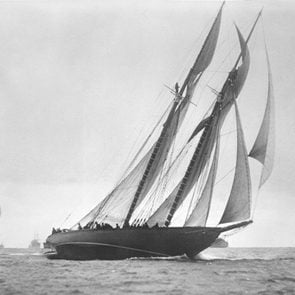How “O Canada” Became Canada’s National Anthem

Composer Calixa Lavallée is one of the most important Canadians you've never heard of.
We all know the feeling. An unexpected constriction in the throat. Heat rising to the face. Tears welling in the corner of our eyes.
We’re responding to “O Canada.”
Maybe we’re watching the Olympics, seeing our flag ascend to the rafters above a pool or velodrome. Maybe we’re in a high school auditorium before a holiday concert, listening to a student band. Or celebrating with people from all over the world as they navigate Canada’s anthem minutes after receiving their Canadian citizenship.
“O Canada” touches us when our sense of pride and place and identity connect, and it creates in us a patriotic reaction that can burst out unexpectedly, for no reason—or many.
We are not entirely sure what to make of our patriotism in a modern, ultra-connected, digitally expanded world. And it frightens us when we encounter it too baldly. We know from experience that the nationalism that follows patriotic pride can wrench some of the most destructive elements out of the human heart. Nationalism and civility, nationalism and peace, nationalism and reason, are frequently bitter enemies.
Yet there it is—that pride, love and joy in community that the anthem brings us.
The Origins of the Canadian National Anthem
“O Canada” has long been the song of our nation, working its steady way into the hearts and lungs of the population, although it did not become the official Canadian national anthem until 1980.
That’s not as unusual as you might think. “The Star-Spangled Banner” didn’t get official status until 1931. “God Save the Queen” has never been proclaimed Great Britain’s national anthem. Because of their combination of emotion, politics, history and symbolism, anthems have long been subjects of controversy. And ours is no exception. Nearly a century and a half after “O Canada” first appeared in 1880, we’re still arguing about its appropriate English lyrics.
Where did Canada’s national anthem come from, this piece of music that affects us so? And who is the person who put our country’s essence into song?

Who Composed the Canadian National Anthem?
Meet the most important Canadian you’ve probably never heard of: Calixa Lavallée. Swashbuckling and irreverent, he was a composer, performer, entrepreneur and educator. He left home in 1855 at 12 years old, worked as a blackface minstrel throughout the United States, fought in the American Civil War, produced operas, became a leading figure in American music, studied in Paris, tried and failed to create a Quebec national conservatory, and died in exile in the U.S.
And he wrote “O Canada.”
It Was Originally Written in French
The story behind the composition of the Canadian national anthem is a mystery to us because it represents a wound we constantly try to mend or hide: we were founded by French and English cultures in this country, to say nothing of the Indigenous peoples who were colonized. The reason no one can be certain of the English words to “O Canada” is that there are no English words, or at least there weren’t any when the song first appeared. “O Canada” wasn’t written in English for English Canadians—it was written in French for French Canadians.
The song premiered on Saint-Jean-Baptiste Day, Quebec’s national holiday, because it was commissioned by the Saint-Jean-Baptiste Society to be a chant national—a national anthem, exclusively for French Canada. All the English versions are either translations of the original or new words fitted to an existing melody. The story of Calixa Lavallée and of his anthem is a tale almost exclusively of French Canada.
Discover the fascinating story of how the provincial flowers of Canada were chosen.
“O Canada” in Context
To understand the Canadian national anthem is to return to the Canada of the last half of the 19th century, a nation in utero, bringing together old hatreds and novel political possibilities as culture faced culture, religion faced religion, economy faced economy. It was a time when forces of change on the North American continent were banging into each other. A waning British colonialism; an America weakened by its Civil War; a Canada both fearful and excited for its future; a Quebec torn by its past, its future and its present—this was the backdrop to the life of Calixa Lavallée.
When you add to that an artist of superior talent with a personality addicted to adventure, a mind clear and concise, and a temperament both calculating and wild, you have a first-rate tale—the story of a man who sat down at his piano in Quebec City in the spring of 1880 and stood up soon thereafter with a nation’s soul on a piece of paper in his hand.
Now that you know the origins of Canadian national anthem, find out how Canada got its name.
Excerpted from Song of a Nation, by Robert Harris. Copyright © 2018, by Robert Harris. Published by McLelland & Stewart, a division of Penguin Random House Canada Limited. Reproduced by arrangement with the Publisher. All rights reserved.






